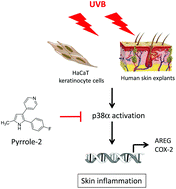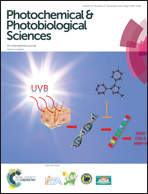Integrating targeted gene expression and a skin model system to identify functional inhibitors of the UV activated p38 MAP kinase
Abstract
The stress-activated p38α MAP Kinase is an integral and critical component of the UV-induced inflammatory response. Despite the advances in recent years in the development of p38 kinase inhibitors, validation of these compounds in the diseased models remains limited. Based on the pharmacological profile of p38α inhibitor lead compound, SB203580, we synthesized a series of pyrrole-derivatives. Using UV-irradiated human skin punch-biopsies and cell cultures, we identified and validated the inhibitory activity of the derivatives by quantitatively measuring their effect on the expression of p38α target genes using real-time PCR. This approach not only identified pyrrole-2 as a unique derivative of this series that specifically inhibited the UV-activated p38α kinase, but also documented the skin permeation, bioavailability and reversible properties of this derivative in a 3D structure. The successful skin permeation of pyrrole-2 and its impact on AREG, COX-2 and MMP-9 gene expression demonstrates its potential use in modulating inflammatory processes in the skin. This study underscored the importance of using adapted biological models to identify accurate bioactive compounds.


 Please wait while we load your content...
Please wait while we load your content...